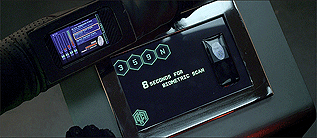Well-Known Member

OUT OF CHARACTER INFORMATION
Intent: To create a biometric lock cracker
Image Source: Momentum (movie)
Canon Link: N/A
Development Thread: If Required
Primary Source: False Eye, False Touch
PRODUCTION INFORMATION
Manufacturer: Ceredir Industries
Model: Althenihen (Lit: Not-true eye)
Affiliation: Closed-Market (approved purchasers)
Modularity: No, but can be paired with other devices (see description)
Production: Mass Produced
Material: Electronics, memory chips, ultra-high definition screens, ultra-high fidelity speaker
Size: 3.81 cm (width) ; 9.14 cm (height) ; 0.5 cm (thickness)
SPECIAL FEATURES
- Capable of ultra-high quality detail
DETAILED SPECIAL FEATURES
- Outputs data with lifelike quality, whether stored on internal memory or from a paired device.
Strengths:
+ High-def: Can replicate common biometric data with lifelike quality
+ Size: Small size makes it simple to slip in unnoticed
+ Pairable: Can be paired with external devices
Weaknesses:
- Highly vulnerable to EMP/Ion: Device is easily disabled, and memory chips may be wiped or corrupted
- Replication: Can only replicate the quality of the provided data, no active enhancement
- Size: Small size means it can't replicate larger biometric scans; anything larger than a fingerprint or eye is too large
- 'Dumb': This is not a device intended to actively crack security, relies on pre-saved data or external device
- Quiet: While the speaker provides excellent quality, it is not very loud
DESCRIPTION
There is security in uniqueness. Having a password is good, but it can be cracked. Biometric security, on the other hand, tends to be more secure as it is unique to you. Only by cloning can an eye be replicated, otherwise it would need to be physically obtained in some manner. Doing either can attract unwanted attention. Althenihen makes things simpler. By obtaining a scan of the eye or a fingerprint, the device can replicate the biometric 'key' and thus allow access to whatever is protected by it.

Understanding the drawbacks of such a device however, Ceredir designers ensured that it could pair with other compatible units. The simplest of these could be a small, portable datapad that carried extra storage. The best could be a modified Security Descrambler. Of course, the efficiency of such pairings was entirely dependent on the other device used, no guarantees were made by Ceredir in terms of compatibility or results.
There were concerns with the creation of this sort of device, and rightfully so. Intended for intelligence services, it could easily be abused by thieves. It was decided that any buyers would need to be vetted before their purchases were approved. A simple criminal background check for individuals, or a more thorough investigation for organizations.








